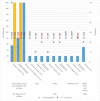Ozone potential to fight against SAR-COV-2 pandemic: facts and research needs
- PMID: 33389580
- PMCID: PMC7778500
- DOI: 10.1007/s11356-020-12036-9
Ozone potential to fight against SAR-COV-2 pandemic: facts and research needs
Abstract
The greatest challenge the world is facing today is to win the battle against COVID-19 pandemic as soon as possible. Until a vaccine is available, personal protection, social distancing, and disinfection are the main tools against SARS-CoV-2. Although it is quite infectious, the SARS-CoV-2 virus itself is an enveloped virus that is relatively fragile because its protective fatty layer is sensitive to heat, ultraviolet radiation, and certain chemicals. However, heat and liquid treatments can damage some materials, and ultraviolet light is not efficient in shaded areas, so other disinfection alternatives are required to allow safe re-utilization of materials and spaces. As of this writing, evidences are still accumulating for the use of ozone gas as a disinfectant for sanitary materials and ambient disinfection in indoor areas. This paper reviews the most relevant results of virus disinfection by the application of gaseous ozone. The review covers disinfection treatments of both air and surfaces carried out in different volumes, which varies from small boxes and controlled chambers to larger rooms, as a base to develop future ozone protocols against COVID-19. Published papers have been critically analyzed to evaluate trends in the required ozone dosages, as a function of relative humidity (RH), contact time, and viral strains. The data have been classified depending on the disinfection objective and the volume and type of the experimental set-up. Based on these data, conservative dosages and times to inactivate the SARS-CoV-2 are estimated. In small chambers, 10-20 mg ozone/m3 over 10 to 50 min can be sufficient to significantly reduce the virus load of personal protection equipment. In large rooms, 30 to 50 mg ozone/m3 would be required for treatments of 20-30 min. Maximum antiviral activity of ozone is achieved at high humidity, while the same ozone concentrations under low RH could result inefficient. At these ozone levels, safety protocols must be strictly followed. These data can be used for reducing significantly the viral load although for assuring a safe disinfection, the effective dosages under different conditions need to be confirmed with experimental data.
Keywords: COVID-19; Coronavirus; Disinfections; Heat & liquid sensitive materials; Ozone gas; SARS-CoV-2.
Conflict of interest statement
The authors declare that they have no conflict of interest.
Figures




Similar articles
-
Ozone Eliminates SARS-CoV-2 from Difficult-to-Clean Office Supplies and Clinical Equipment.Int J Environ Res Public Health. 2022 Jul 16;19(14):8672. doi: 10.3390/ijerph19148672. Int J Environ Res Public Health. 2022. PMID: 35886529 Free PMC article.
-
Ozone Disinfection for Elimination of Bacteria and Degradation of SARS-CoV2 RNA for Medical Environments.Genes (Basel). 2022 Dec 28;14(1):85. doi: 10.3390/genes14010085. Genes (Basel). 2022. PMID: 36672826 Free PMC article.
-
An automated room disinfection system using ozone is highly active against surrogates for SARS-CoV-2.J Hosp Infect. 2021 Jun;112:108-113. doi: 10.1016/j.jhin.2021.04.007. Epub 2021 Apr 15. J Hosp Infect. 2021. PMID: 33864891 Free PMC article.
-
Ozone based inactivation and disinfection in the pandemic time and beyond: Taking forward what has been learned and best practice.Sci Total Environ. 2023 Mar 1;862:160711. doi: 10.1016/j.scitotenv.2022.160711. Epub 2022 Dec 7. Sci Total Environ. 2023. PMID: 36496014 Free PMC article. Review.
-
A critical mini-review on challenge of gaseous O3 toward removal of viral bioaerosols from indoor air based on collision theory.Environ Sci Pollut Res Int. 2023 Aug;30(36):84918-84932. doi: 10.1007/s11356-023-28402-2. Epub 2023 Jun 29. Environ Sci Pollut Res Int. 2023. PMID: 37380862 Review.
Cited by
-
Ozone Eliminates SARS-CoV-2 from Difficult-to-Clean Office Supplies and Clinical Equipment.Int J Environ Res Public Health. 2022 Jul 16;19(14):8672. doi: 10.3390/ijerph19148672. Int J Environ Res Public Health. 2022. PMID: 35886529 Free PMC article.
-
COVID-19 pandemic influence on perceived exposure to chemical substances in Latvia: data from a focus group discussion and the HBM4EU citizen survey.Front Public Health. 2024 May 23;12:1382368. doi: 10.3389/fpubh.2024.1382368. eCollection 2024. Front Public Health. 2024. PMID: 38846609 Free PMC article.
-
Efficacy of ozone adjuvant therapy in COVID-19 patients: A meta-analysis study.Front Med (Lausanne). 2022 Nov 10;9:1037749. doi: 10.3389/fmed.2022.1037749. eCollection 2022. Front Med (Lausanne). 2022. PMID: 36438064 Free PMC article. Review.
-
Mask disinfection using atmospheric pressure cold plasma.Int J Infect Dis. 2022 Oct;123:145-156. doi: 10.1016/j.ijid.2022.08.012. Epub 2022 Aug 19. Int J Infect Dis. 2022. PMID: 35995313 Free PMC article.
-
Advances in ozone technology for preservation of grains and end products: Application techniques, control of microbial contaminants, mitigation of mycotoxins, impact on quality, and regulatory approvals.Compr Rev Food Sci Food Saf. 2025 May;24(3):e70173. doi: 10.1111/1541-4337.70173. Compr Rev Food Sci Food Saf. 2025. PMID: 40260769 Free PMC article. Review.
References
-
- Blanchard EL, Lawrence JD, Noble JA, Xu M, Joo T, Ng NL, Schmidt BE, Santangelo PJ, Finnd MD (2020). Enveloped virus inactivation on personal protective equipment by exposure to ozone. Preprint Not peer reviewed medRxiv doi: 10.1101/2020.05.23.20111435
-
- Boast N, Heselton D, Hudson J, Manu S (2008). Apparatus and method for using ozone as a disinfectant. United States patent. US 2008/0213125 A1
-
- Cannon JL, Kotwal G, Wang Q, et al. Inactivation of norovirus surrogates after exposure to atmospheric ozone. Ozone Sci Eng. 2012;35(3):217–219. doi: 10.1080/01919512.2013.771953. - DOI
Publication types
MeSH terms
Substances
Grants and funding
LinkOut - more resources
Full Text Sources
Other Literature Sources
Medical
Research Materials
Miscellaneous

